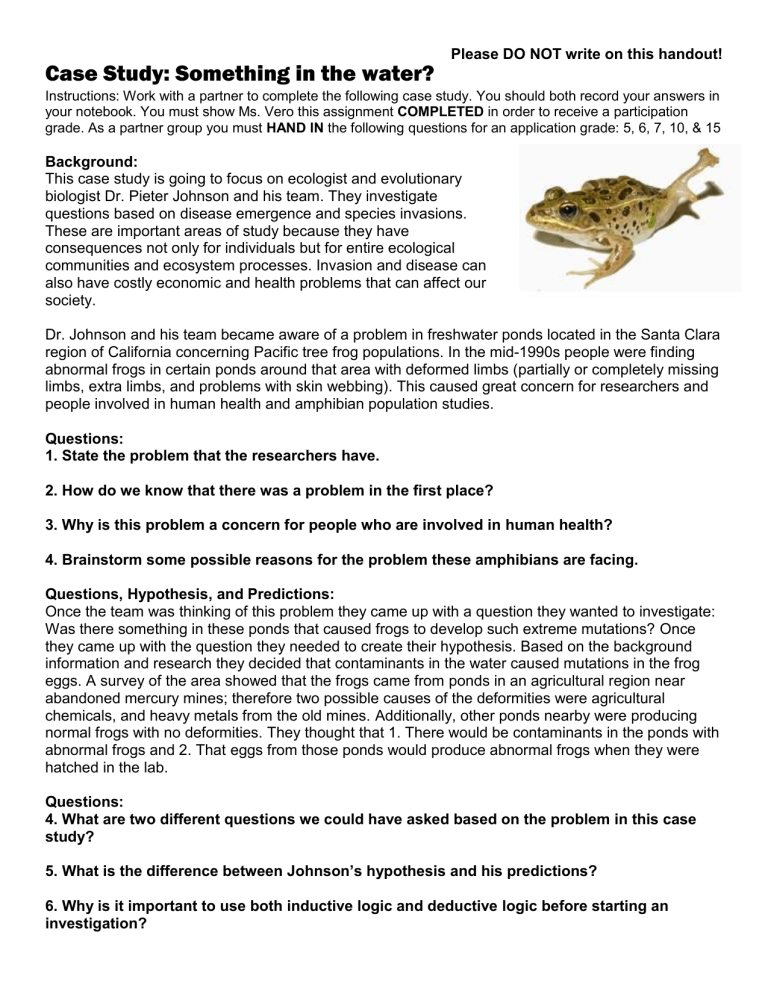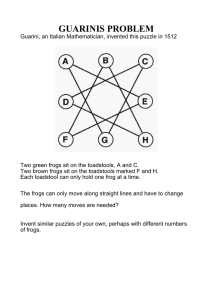Case Study Abnormal Frogs
advertisement

Case Study: Something in the water? Please DO NOT write on this handout! Instructions: Work with a partner to complete the following case study. You should both record your answers in your notebook. You must show Ms. Vero this assignment COMPLETED in order to receive a participation grade. As a partner group you must HAND IN the following questions for an application grade: 5, 6, 7, 10, & 15 Background: This case study is going to focus on ecologist and evolutionary biologist Dr. Pieter Johnson and his team. They investigate questions based on disease emergence and species invasions. These are important areas of study because they have consequences not only for individuals but for entire ecological communities and ecosystem processes. Invasion and disease can also have costly economic and health problems that can affect our society. Dr. Johnson and his team became aware of a problem in freshwater ponds located in the Santa Clara region of California concerning Pacific tree frog populations. In the mid-1990s people were finding abnormal frogs in certain ponds around that area with deformed limbs (partially or completely missing limbs, extra limbs, and problems with skin webbing). This caused great concern for researchers and people involved in human health and amphibian population studies. Questions: 1. State the problem that the researchers have. 2. How do we know that there was a problem in the first place? 3. Why is this problem a concern for people who are involved in human health? 4. Brainstorm some possible reasons for the problem these amphibians are facing. Questions, Hypothesis, and Predictions: Once the team was thinking of this problem they came up with a question they wanted to investigate: Was there something in these ponds that caused frogs to develop such extreme mutations? Once they came up with the question they needed to create their hypothesis. Based on the background information and research they decided that contaminants in the water caused mutations in the frog eggs. A survey of the area showed that the frogs came from ponds in an agricultural region near abandoned mercury mines; therefore two possible causes of the deformities were agricultural chemicals, and heavy metals from the old mines. Additionally, other ponds nearby were producing normal frogs with no deformities. They thought that 1. There would be contaminants in the ponds with abnormal frogs and 2. That eggs from those ponds would produce abnormal frogs when they were hatched in the lab. Questions: 4. What are two different questions we could have asked based on the problem in this case study? 5. What is the difference between Johnson’s hypothesis and his predictions? 6. Why is it important to use both inductive logic and deductive logic before starting an investigation? Please DO NOT write on this handout! The Experiment Pieter Johnson and his team counted frogs and other organisms in 35 ponds in the region where the deformed frogs had been found and measured chemicals in the water. Thirteen of the ponds were home to Pacific tree frogs, but he found deformed frogs in only four ponds. The analysis of the water samples failed to show higher amounts of pesticides, industrial chemicals or heavy metals in the ponds with deformed frogs. Also, when he collected eggs from those ponds and hatched them in the lab, he always got normal frogs. Questions: 7. Based on the information we learned in class what does this mean for the original hypothesis and the predictions? 8. What conclusions can we make based on the results? Next Steps: The team still had questions that were unanswered; what was causing these mutations in Pacific tree frogs? Johnson’s challenge was now to find some difference between the ponds with normal and abnormal frogs. So he compared the two types of ponds to see what variables were different between them. Question: 9. Create a new hypothesis that the team could use to answer their question. The New Experiment: A comparative approach The team formed a new hypothesis; something in the environment is causing developmental limb abnormalities in Pacific tree frogs. They collected samples of the different ponds in order to analyze water chemistry, as well as, looked at the biodiversity of organisms in each pond. Then they looked for correlations between the presence of frog abnormalities and the characteristics of the ponds. They discovered that frogs with limb abnormalities were found in 4 of the 13 ponds. Water and biodiversity surveys showed no difference in water pollution, but it did reveal the presence of snails infested with parasitic flatworms of the genus Ribeiroia in the 4 ponds with abnormal frogs. Table 1: Comparison of ponds with normal and abnormal Pacific Tree Frogs Pesiticide Heavy metals Industrial Snails in residues in in water? Chemicals in water? water? water? Ponds with NO NO NO NO normal frogs YES Ponds with NO NO NO abnormal frogs Ribeiroia in water? Ribeiroia larvae in frogs NO NO YES YES Questions: 10. Why is this approach considered to be a comparative experiment? 11. What is the conclusion we can make based on this new experiment? Please DO NOT write on this handout! A New Experiment: A controlled approach Based on all this discovery and research the team wanted to continue investigating more about abnormal frog growth. Many parasites go through complex life cycles with several stages, each of which requires a specific host animal to survive. Johnson focused on the possibility that some parasite that used freshwater snails as one of its hosts was infecting the frogs and causing their deformities. He decided that since they found the flatworm Ribeiroia in the ponds with the abnormal frogs this was the best candidate to be causing the mutations. The new hypothesis was infection of Pacific tree frog tadpoles by the parasite Ribeiroia causes developmental limb abnormalities. He collected frog eggs from a site with no record of abnormal frogs or snails. Then he hatched them in the lab and monitored them until they were tadpoles. He randomly divided the tadpoles into four groups: control no parasites, with Alaria, with Ribeiroia, with Alaria and Ribeiroia. He allowed the control group to develop normally and infected the experimental groups with Ribeiroia and a different parasite Alaria. The results showed that 85% of the frogs infected with Ribeiroia developed abnormalities while all the other tanks had frogs that developed normally. These results finally supported the hypothesis allowing the team to develop new questions about how the parasites caused abnormalities in developing frogs. Questions: 12. Explain what all the different variables in the controlled experiment were. 13. What are important considerations when conducting a controlled experiment? 14. What was the final conclusion to support the hypothesis? 15. Based on this case study write a few sentences about what you learned about applying the scientific method. APA Reference Johnson, Pieter (2013). Amphibian malformations. Retrieved from http://www.colorado.edu/eeb/facultysites/pieter/amphibianmalformations.html#trematode




